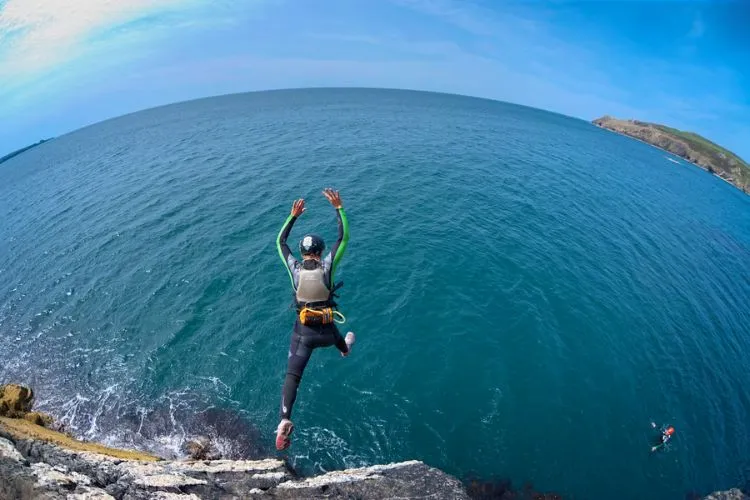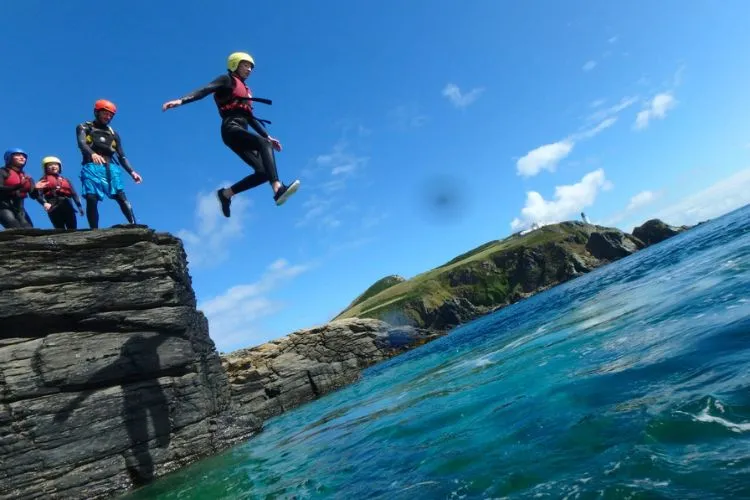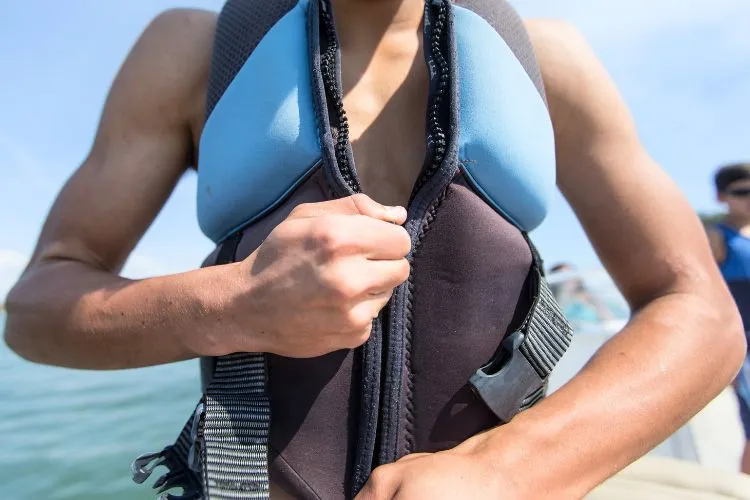Cliff diving, a breathtaking leap from towering heights into water, captivates thrill-seekers worldwide with its blend of adrenaline and natural beauty.
This extreme sport, however, is not without its risks, asking an important question: can you cliff dive with a life jacket?

This article delves into the feasibility and safety implications of cliff diving with a life jacket, offering insights for enthusiasts eager to marry the thrill of the dive with an added layer of protection.
Can You Cliff Dive With a Life Jacket?
Yes, you can cliff dive with a life jacket, but it’s not recommended for high cliffs. A life jacket is designed to keep you afloat and can provide some protection upon water entry, potentially reducing the risk of going too deep too quickly.
However, for higher cliffs, the impact with the water can be very forceful, and a life jacket might not offer enough protection against injury from the impact itself. Additionally, the buoyancy of the life jacket can affect your entry position, increasing the risk of injury.
It’s crucial to always prioritize safety by choosing appropriate heights for your skill level and conditions, and consider professional guidance for high or risky jumps. Cliff diving inherently carries risks, and safety measures should be carefully considered.
Safety Precautions in Cliff Diving
Cliff diving is an exhilarating sport that offers an unmatched adrenaline rush. However, it comes with inherent risks that can lead to severe injuries or even fatalities.
As a cliff diving specialist, I cannot emphasize enough the importance of adhering to stringent safety precautions. Let’s delve into the critical steps every diver should take to ensure a safe and enjoyable experience.
Scouting the Diving Area for Hazards
Before even considering a dive, the first and most crucial step is to thoroughly scout the area for potential hazards. This process involves several key aspects:

Assessing Environmental Conditions
- Weather: Never underestimate the impact of weather on cliff diving. High winds, rain, or storms can drastically alter the safety of a dive. Always check the weather forecast before heading out.
- Visibility: Clear water is paramount for spotting underwater hazards. Avoid diving in murky conditions where obstacles like rocks or debris are not visible.
Identifying Physical Obstacles
- Underwater Terrain: The underwater landscape can change rapidly, especially after heavy rains or storms. Be on the lookout for submerged rocks, trees, or other debris that could pose a threat.
- Water Level Fluctuations: Water bodies can experience significant level changes. A spot that was safe to dive into last season might be dangerously shallow now.
Engaging with Local Knowledge
Reaching out to locals, including other divers or lifeguards, can provide invaluable insights into hidden dangers, best times to dive, and anecdotal safety tips often missed by outsiders.
Understanding Water Depth
Judging the appropriate depth for cliff diving is non-negotiable. Here’s how to approach this critical step:
Minimum Depth Requirement
A general rule is that water depth should be at least 2.5 to 3 times the height from which you’re diving. For instance, a 10-meter jump requires a minimum water depth of 25-30 meters to be considered safe.
Dive Spot Verification
- Use a Weighted Rope: Before your first dive, drop a weighted rope into the water to accurately measure depth. This is especially crucial in natural water bodies where depth can be deceptive.
- Check for Depth Consistency: Ensure the chosen dive spot maintains consistent depth across different times or seasons, as underwater currents can shift the seabed.
Having a Safety Plan
Even with thorough preparation, emergencies can happen. Having a robust safety plan is vital:
Dive with a Buddy
Always dive with at least one other person who understands the risks and can assist in case of an emergency. Ideally, this person should have knowledge of basic rescue techniques and first aid.
Communicate Your Plan
Let someone know where you are going and when you expect to return. In remote areas, this step can make a significant difference in the speed and efficiency of rescue efforts if something goes wrong.
Access to Emergency Services
Ensure you have immediate access to a phone or radio to call for help if needed. Familiarize yourself with local emergency numbers and the quickest route to the nearest medical facility.
Wear Protective Gear
While not always fashionable, wearing protective gear such as water helmets and impact vests can substantially reduce the risk of injury.
Cliff diving combines the thrills of adventure sports with the beauty of nature. However, it demands respect, preparation, and a proactive approach to safety.
By thoroughly scouting the diving area, understanding the necessary water depth, and having a clear safety plan, divers can help ensure that their experience is not only exhilarating but safe. Always remember, the best cliff diving experience is one that you can walk away from, ready to dive another day.
Equipment and Gear for Cliff Diving
Undertaking the thrill of cliff diving demands not just courage and skill, but also the right equipment and gear to ensure a safe and comfortable experience.
From protection against the cold to safeguards against impact, let’s review the specialized equipment used in cliff diving, focusing on the purpose of each item and the criteria for selecting the best gear.
Wetsuits
Purpose
Wetsuits are designed to provide thermal insulation, abrasion resistance, and buoyancy. The insulating properties of a wetsuit allow divers to maintain body heat in cold water conditions, which is critical for comfort and preventing hypothermia.

Selection Criteria
When choosing a wetsuit for cliff diving:
- Thickness: The temperature of the diving environment will dictate the thickness required. Thickness typically ranges from 2 mm for warm water to 7 mm for cold water.
- Fit: A proper fit is essential. The wetsuit should be snug enough to prevent excessive water flow but not so tight that it restricts movement or breathing.
- Style: Full suits cover most of the body and are suitable for colder waters. Shorties, which leave arms and legs exposed, are an option for warmer conditions.
Water Helmets
Purpose
Water helmets provide head protection from collisions with water at high velocities or accidental impact with rocks and debris. They can be crucial for preventing concussions and other head injuries.
Selection Criteria
Optimal water helmets should be:
- Certified: Look for helmets that meet international safety standards such as CE EN 1385.
- Properly Fitted: The helmet should fit snugly without being uncomfortably tight. It shouldn’t move when you shake your head.
- Ventilated: Good ventilation helps manage water flow and comfort during a dive.
- Retention System: A secure strap system prevents the helmet from slipping off on impact with the water.
Life Jackets (Impact Vests)
Purpose
Life jackets serve to increase buoyancy, which can assist with surface swimming and safety, especially in turbulent water conditions. Impact vests provide additional benefits, such as protection from the force of impact when hitting the water.

Selection Criteria
To select the right life jacket or impact vest:
- Buoyancy: Ensure sufficient buoyancy for your body weight. More isn’t necessarily better as too much can make swimming difficult.
- Fit: A life jacket or vest must fit comfortably — not too loose that it could slip off, and not too tight to restrict movement.
- Material: Durable and quick-drying materials will enhance comfort and longevity.
- Visibility: Bright colors can enhance visibility in the water, aiding quicker rescue if necessary.
Additional Gear
While wetsuits, helmets, and life jackets are the cornerstone of safety gear for cliff diving, several other pieces of equipment can enhance safety and comfort:
- Dive Watches: A good dive watch can help track dive times and surface intervals, which might be of interest for repetitive diving sessions.
- Ear Plugs: These can protect against ear infections and the discomfort caused by water pressure changes, known as ‘ear squeeze’.
- Foot Protection: Specialized water shoes or booties can offer protection against sharp rocks and provide better grip on slippery surfaces.
Conclusion:
The right cliff diving equipment and gear not only increase the safety factor of the sport but also enhance the overall experience by providing the diver with the confidence to perform better.
Whether you’re a seasoned professional or a newcomer to the sport, investing in the correct gear suited to your needs and the conditions is imperative for safe and enjoyable cliff diving adventures.
Always seek guidance from professionals when selecting equipment and ensure that it is properly maintained and inspected before each dive session.


